Related Research Articles
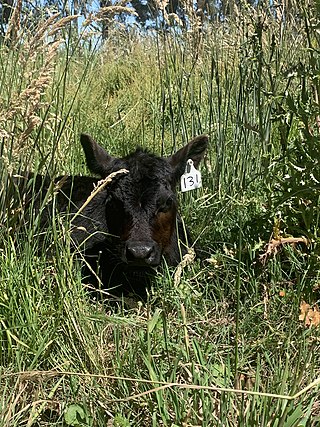
A calf is a young domestic cow or bull. Calves are reared to become adult cattle or are slaughtered for their meat, called veal, and their hide.

Rodeo is a competitive equestrian sport that arose out of the working practices of cattle herding in Spain and Mexico, expanding throughout the Americas and to other nations. It was originally based on the skills required of the working vaqueros and later, cowboys, in what today is the western United States, western Canada, and northern Mexico. Today, it is a sporting event that involves horses and other livestock, designed to test the skill and speed of the cowboys and cowgirls. American-style professional rodeos generally comprise the following events: tie-down roping, team roping, steer wrestling, breakaway roping, saddle bronc riding, bareback bronc riding, bull riding and barrel racing. The events are divided into two basic categories: the timed events and the roughstock events. Depending on sanctioning organization and region, other events such as steer roping, goat tying, and pole bending may also be a part of some rodeos. The "world's first public cowboy contest" was held on July 4, 1883, in Pecos, Texas, between cattle driver Trav Windham and roper Morg Livingston.

A cowboy is an animal herder who tends cattle on ranches in North America, traditionally on horseback, and often performs a multitude of other ranch-related tasks. Cattle drives ensure the herds health in finding pasture and bring them to market. The historic American cowboy of the late 19th century arose from the vaquero traditions of northern Mexico and became a figure of special significance and legend. A subtype, called a wrangler, specifically tends the horses used to work cattle. In addition to ranch work, some cowboys work for or participate in rodeos. Cowgirls, first defined as such in the late 19th century, had a less well-documented historical role, but in the modern world work at identical tasks and have obtained considerable respect for their achievements. Cattle handlers in many other parts of the world, particularly in South America and stockmen and jackaroos in Australia, perform work similar to the cowboy.
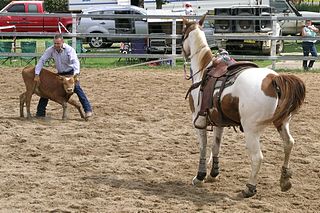
Calf roping, also known as tie-down roping, is a rodeo event that features a calf and a rider mounted on a horse. The goal of this timed event is for the rider to catch the calf by throwing a loop of rope from a lariat around its neck, dismount from the horse, run to the calf, and restrain it by tying three legs together, in as short a time as possible. A variant on the sport, with fewer animal welfare controversies, is breakaway roping, where the calf is roped, but not tied.

The Aberdeen Angus, sometimes simply Angus, is a Scottish breed of small beef cattle. It derives from cattle native to the counties of Aberdeen, Banff, Kincardine and Angus in north-eastern Scotland. In 2018 the breed accounted for over 17% of the beef production in the United Kingdom.

Weaning is the process of gradually introducing an infant human or another mammal to what will be its adult diet while withdrawing the supply of its mother's milk. In the UK, weaning primarily refers to the introduction of solid foods at 6 months; in the US, it primarily refers to stopping breastfeeding.

Dairy cattle are cattle bred with the ability to produce large quantities of milk, from which dairy products are made. Dairy cattle generally are of the species Bos taurus.

Rodeos have long been a popular competitor and spectator sport in Australia, but were not run on an organised basis until the 1880s.

Cutting is a western-style equestrian competition in which a horse and rider work together before a judge or panel of judges to demonstrate the horse's athleticism and ability to handle cattle. Modern competition utilizes a 2+1⁄2 minute performance, called a "run." Each contestant is assisted by four helpers: two are designated as turnback riders, who help to keep cattle from running off to the back of the arena, the other two are designated as herd holders to keep the cattle bunched together and prevent potential strays from escaping into the work area. Cutting cattle are typically young steers and heifers that customarily range in size from 400 to 650 lb. They usually are of Angus or Hereford lineage though may be a mix of crossbred beef cattle, including Charolais Braford or Brahman lineage.
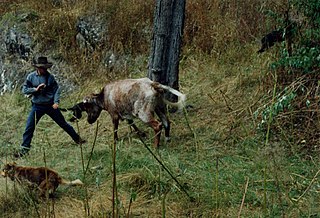
A muster (Au/NZ) or a roundup (US/Ca) is the process of gathering livestock. Musters usually involve cattle, sheep or horses, but may also include goats, camels, buffalo or other animals. Mustering may be conducted for a variety of reasons including routine livestock health checks and treatments, branding, shearing, lamb marking, sale, feeding and transport or droving to another location. Mustering is a long, difficult and sometimes dangerous job, especially on the vast Australian cattle stations of the Top End, 'The Falls' (gorge) country of the Great Dividing Range and the ranches of the western United States. The group of animals gathered in a muster is referred to as a "mob" in Australia and a "herd" in North America.
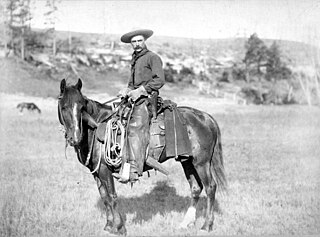
Western riding is considered a style of horse riding which has evolved from the ranching and welfare traditions which were brought to the Americas by the Spanish Conquistadors, as well as both equipment and riding style which evolved to meet the working needs of the cowboy in the American West. At the time, American cowboys had to work long hours in the saddle and often over rough terrain, sometimes having to rope a cattle using a lariat, also known as a lasso. Because of the necessity to control the horse with one hand and use a lariat with the other, western horses were trained to neck rein, that is, to change direction with light pressure of a rein against the horse's neck. Horses were also trained to exercise a certain degree of independence in using their natural instincts to follow the movements of a cow, thus a riding style developed that emphasized a deep, secure seat, and training methods encouraged a horse to be responsive on very light rein contact.
History of rodeo tracks the lineage of modern Western rodeo.

A stock horse is a horse of a type that is well suited for working with livestock, particularly cattle. The related cow pony or cow horse is a historic phrase, still used colloquially today, referring to a particularly small agile cattle-herding horse; the term dates to 1874. The word "pony" in this context has little to do with the animal's size, though the traditional cow pony could be as small as 700 to 900 pounds and less than 14 hands high.

The Spade Ranch is a large cattle ranch located in the Sandhills of western Nebraska between the towns of Gordon and Ellsworth. Founded in 1888 by Bartlett Richards, the ranch was placed on the National Register of Historic Places in 1980.
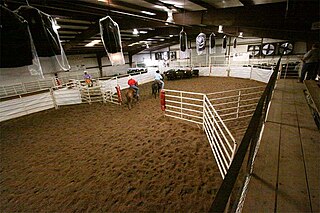
Ranch sorting is a western-style equestrian sport that evolved from the common ranch work of separating cattle into pens for branding, doctoring, or transport. Ranch Sorting is an event that pits a team of two riders on horseback against the clock. Teamwork is the key with both riders working in harmony to cut out the correct cattle and drive them to the pen while keeping the wrong numbered cattle back. There are several variations of ranch sorting with one, two or three riders on the team, but all require sorting the cattle from one pen to the other in the correct order.

Cattle are large, domesticated, bovid ungulates widely kept as livestock. They are prominent modern members of the subfamily Bovinae and the most widespread species of the genus Bos. Mature female cattle are called cows and mature male cattle are bulls. Young female cattle are called heifers, young male cattle are oxen or bullocks, and castrated male cattle are known as steers.

A stock contractor is an individual or business that provides animals for rodeo competition. Stock contractors supply rough stock - bucking horses for saddle bronc and bareback bronc riding and bucking bulls for bull riding, plus steers for steer wrestling and team roping, plus calves for calf roping and breakaway roping events. The use of stock contractors who specialize in providing these animals has produced a more uniform range of bucking stock which is also quieter to handle.
Robert Mills Grant, known as Bob Grant, was a third-generation rancher from Platte County in southern Wyoming and from 1983 to 1992 a Republican member of the Wyoming House of Representatives.

Wild cow milking is a rodeo event seen at mainstream and ranch rodeos. A team-based competition, the goal is to catch and milk a "wild" cow in as short a time as possible. The competition dates back at least to the early 20th century, with competitions at the Cheyenne Frontier Days rodeo photographed as far back as 1924.
References
- ↑ "Ranch Rodeo Finals". www.sarodeo.com. February 26, 2012. Archived from the original on February 8, 2012. Retrieved August 24, 2023.
- ↑ Culver, Galen (August 22, 2014). "Great State: Ranch Rodeo Practice is Everyday Work for These Cowboys Near Velma, OK". KFOR. Retrieved May 12, 2015.
- ↑ "South Texas Ranch Rodeo". Archived from the original on July 8, 2008. Retrieved August 20, 2023.
{{cite web}}: CS1 maint: unfit URL (link) - ↑ "Ranch Rodeo". www.blackhillsroundup.com. July 3, 2013. Archived from the original on June 25, 2013. Retrieved August 19, 2023.
- ↑ "OCA Range Round-Up". www.okcattlemen.org. Archived from the original on August 22, 2013. Retrieved August 18, 2023.
- ↑ "2014 OCA Range Roundup Rodeo Results". wrca.org. August 26, 2014. Retrieved May 12, 2015.
- ↑ "Working Ranch Cowboys Association". Working Ranch Cowboys Association. Retrieved September 7, 2024.
- ↑ "Western States Ranch Rodeo Association". Western States Ranch Rodeo Association. Retrieved September 7, 2024.
- ↑ "Calf branding". Archived from the original on March 13, 2002. Retrieved August 22, 2023.
{{cite web}}: CS1 maint: unfit URL (link) - ↑ "Steer Doctoring". Archived from the original on January 31, 2002. Retrieved August 21, 2023.
{{cite web}}: CS1 maint: unfit URL (link) - ↑ "Team penning". Archived from the original on May 9, 2002. Retrieved August 17, 2023.
{{cite web}}: CS1 maint: unfit URL (link) - ↑ "Wild Horse Race |". Archived from the original on November 30, 2019. Retrieved May 12, 2015.
- ↑ "Wild Cow Milking". Archived from the original on July 18, 2002. Retrieved August 15, 2023.
{{cite web}}: CS1 maint: unfit URL (link)